Blog Archives
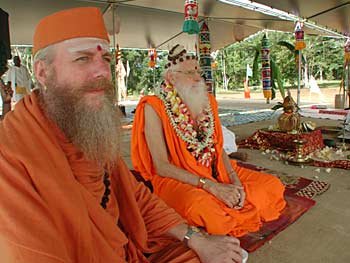
Gurudeva and Paramacharya Ceyonswami at the first stone laying ceremony of Iraivan Temple. In Dancing with Siva Gurudeva writes:
Sloka 102 from Dancing with Siva
How Are Temples Founded and Built?
Siva temples are founded by God Himself, often designated in a vision or dream of a devout Saivite, then erected by temple craftsmen usually following Agamic law. In such a holy place, holiness itself can reside. Aum.
Bhashya
Because of its holiness, a Siva temple is most often and properly established by God Siva through His devotees and not founded by men. Once the site is known, hereditary temple architects, known as sthapatis, are commissioned to design and construct the temple. By tradition, every stone is set in place according to the sacred architecture found in the Agamic scriptures. When properly consecrated, the temple becomes a place upon the earth in which the three worlds can communicate for the upliftment of mankind and the fulfillment of Siva’s dharmic law. Siva has deliberately established many temples to communicate His love to His children throughout the world, who live in every country of the world and long for their Lord’s ever-present love. They build temples in His name and install His image, chant His praises and thus invoke His presence. Lord Siva accepts all these temples as His own and sends a divine ray to vivify and vitalize them. Siva’s Vedas annunciate, “Brahman is the priest, Brahman the sacrifice; by Brahman the posts are erected. From Brahman the officiating priest was born; in Brahman is concealed the oblation.” Aum Namah Sivaya.
Our Beloved and Revered Satguru Sivaya Subramuniyaswami
Attained Maha Samadhi on November 12th, 2001
Click to read for Details.
Mystic Mouse Coloring Book Now available
Today’s sample page. —– Click here to get your copy today!
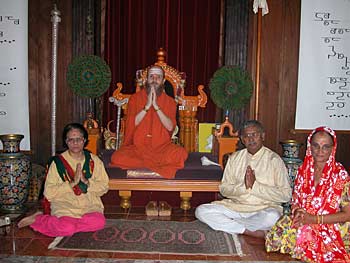
Pandit Sharma and his wife Asha on the right and Asha Chakku on the left, had darshan today with Bodhinatha. This was their last day here at the Aadheenam on their pilgrimage. They are going home spiritually renewed to carry on their mission and service in Houston through the Hindu Worship Society. Unlike many temples where only the rituals are performed and festivals held, the Hindu Worship Society also carries on a “preaching” service. Pundit takes the time to speak to the congregation. Besides seeing to the performance of the regular pujas, aratis and archanas, Gurudeva has encouraged the priests of Hindu temples in America to take a more complete role in their work: to lead, teach and guide the temple devotees. The doctors, engineers and professionals who form the boards of trustees are frequently there simply because of their large donations and the priests are often relegated to the position of servants and sent back to India after short terms and there are no acharyas or gurus involved. Thus, these temples are running in a vacuum of ordained spiritual leadership and have no authorized clergy to represent their temple in the community forum of other religious leaders. So, Panditji and his wife are setting a good example for other temple societies.
Asha Chakku asked for advice from Bodhinatha about her desires to help with the children of the villages of India. He advised her to get in touch with Udayan Care an orphanage in India that also has a fund in the Hindu Heritage Endowment.
No Audio Today
|
Take this opportunity for an adventure. Close your eyes and click to get a message picked at random from the vast audio archives of our Satgurus’ discourses |
And click here for an Index to All Past CyberTalks. Study Gurudeva’s teachings. Visit the Master Course site! |
 |
|
|
|
|
 |
||||
Yogi Mahadeva is our main host these days and spends a lot of time with guests in the morning. In the afternoons he carries on with his work in the Ekadanta Kulam, helping with a wide variety of tasks, including communications relating to Hindu Heritage Endowment and the Kauai Aloha Endowment desk that Gurudeva established at the monastery as another, behind the scenes, community service to the island of Kauai.
Here he is sending out personal notes of appreciation and receipts for tithing made by members of Saiva Siddhanta Church and also for donors to various funds of the Hindu Heritage Endowment. If you are looking for a solid vehicle for financial support and charitable giving toward Hindu Dharma… check out the HHE website.
What is this marvelous looking specimen of a potted plant, you may be wondering? It is a gift to the monastery. A wonderful tree, 10 feet tall, that a devotee brought to us yesterday. One of the world’s most outstanding flowering trees and quite uncommon. It is so large in the pot it will probably flower next summer.
Colvillea racemosa – Colville’s Glory
One of the most spectacular of the flowering trees, this species grows to around 45 feet in South Florida. The attractive trunk is reminiscent of the native Gumbo Limbo while the foliage is similar to that of the Royal Poinciana. The tree is a member of the Caesalpiniaceae family and native to Madagascar. It likes full sun and a period of dry weather before flowering in the fall. C. racemosa is semi-deciduous, meaning degree and duration of winter leaf drop is dependent upon the weather. Good for summer shade and park and street planting. Spikes of brilliant orange flowers are held above the foliage and attract nectar-feeding birds.
 The Remarkable Vision |
Iraivan Temple Progress Update |
Join this historic undertaking. Please contribute generously. Sponsor a stone today! |
| Order Sacred Rudrakshas or Gorgeous 2003 Iraivan Calendars with Hindu festival days on them. Great for Gifts! All proceeds go to the building fund. | ||
We bring you a fascinating series to day of Shanmugam Sthapati and his team in the process of stone positioning and alignment. Tools of the trade are red colored concrete stain (in place of the ancient “kavi” stain originally used in india), simple string, plub bob and rulers.
Marking paste made from concrete stain.
The position of stones at certain levels is further out than stones at lower levels.. Adaikkalam and Sundaram Achari hold the line.
The red lines mark the “edge” of the temple and where the stones below and above should be placed. With projecting ornamentation, it is more than just a matter of making the face of the stone flush with the ones below it. They must be placed precisely according to the plans originally drafted by Ganapati Sthapati in India. This is how they go around the projecting material.
Raman sights the line dropping from above with another measuring stick.
Andiappan and Raman confirm the measurements. Slowly but surely each stone finds its final resting place to be here for 1000 years or more.
Saiva Siddhanta Church
Gold Gate Mission
Iraivan Fund Raising Activities
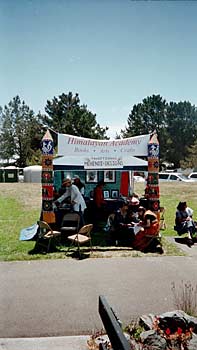
Here are some photos of the fundraising booth at the Berkeley Marina earlier this summer. The Banner says “Himalayan Academy, Books, Art, Crafts, Traditional Mehendi Designs.” Chandran Param and family with other Golden Gate Mission members set the booth up in the morning.
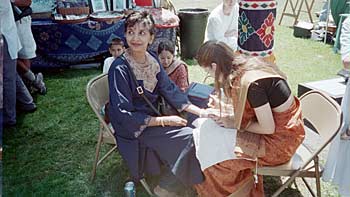
Artistic members drew mahendi designs on patrons’� hands.� Receiving the body art application� is Anandi Nagalingam, Sundari Katir’s sister visiting from England.
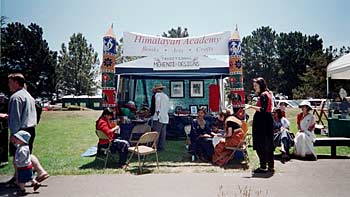
The summer fair lasted all day in Berkeley, California.
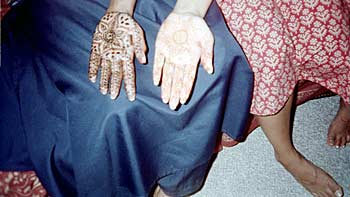
The finished product.�� Anandi Nagalingam and Venita Katir
Gurudeva’s spiritual center in the island country of Mauritius
in the Indian Ocean near South Africa

Bodhinatha’s recent visit to Mauritius has inspired so many devotees who closely accompanied His Holiness to all the temples visited and to the Spiritual Park too. Here, everyone is at the very beautiful open space where majestically stands Lord Muruga overlooking the turquoise lagoon on the east. Bodhinatha and all the devotees are worshipping Lord Muruga while �the cool and melting sea breeze is blowing over them the soothing shakti of the Lord.
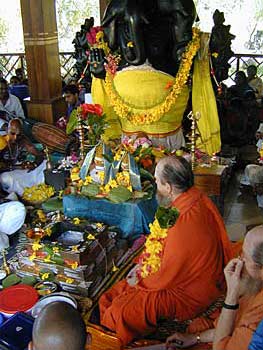
On Ganesha Chaturthi day, a beautiful Homa was performed by �Natyam Tyaganatha from Kauai. A special Peedham �was placed at the Feet of Lord Pancha Mukha Ganapathi for Bodhinatha.

While the chanting of holy mantras pervaded the Mandapam, devotees seated on the Mandapam floor enjoyed the darshan of a great embodied Soul in their midst. �
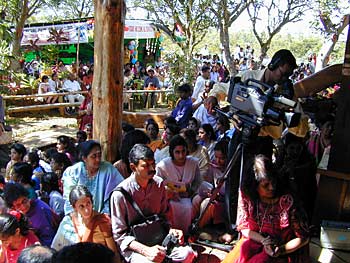
The local television crew from MBC was there to record the whole ceremony for a documentary. One of their main themes would be the burning of notes to devas or angelic beings in the sacred Homa fire. This old practice is even �little known to many modern hindus.
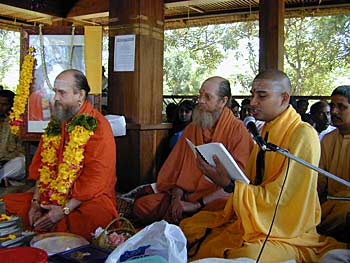
All those who attended the Ganesha Chaturthi ceremony would not forget so easily the beautiful Sri Rudram chanted by Yogi Mahadeven while Natyam Tyaganatha was taking care of the fire. The atmophere all through was charged by a high spiritual vibration. �
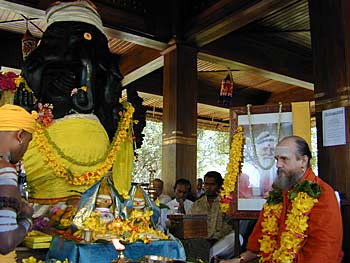
The Mahadeva and the Holy Satguru. Both knows best the needs of the devotee and gently help them evolve through their karmas. Mauritius devotees here, usually known to be fully immersed in Temple worship, are now lovingly emerging to seek the guidance of a �SatGuru in their spiritual quest.
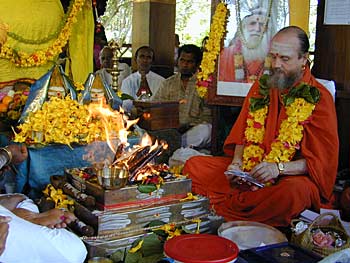
It is not every month that a Satguru is there at the Mandapam to burn the notes of the devotees in the sacred fire. Here is Bodhinatha lovingly putting hundreds of written prayers into the fire. The inner worlds cannot miss them!
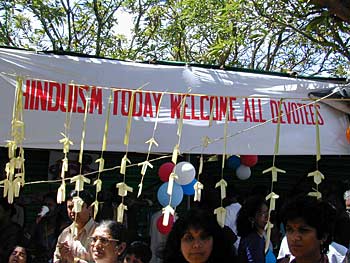
Here is the the prow of the ship of Saiva Siddhanta Church �as Gurudeva said it. A banner for Hinduism Today,our monthly Magazine which is undergoing a new take off in the island of Mauritius. This banner was happily floating at the Spiritual Park on Ganesha Chaturthi. Welcome to you too!
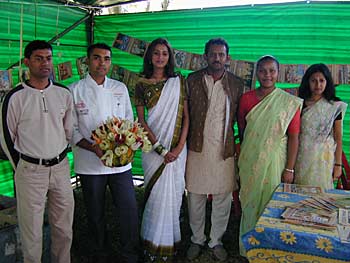
This is a wonderful team of Hinduism Today promoters who did a remarkable seva on that auspicious day. Here is Kulapati Mougam Periatumbee and his humble team. Kulapati Mougam took it as a challenging seva to boost up the subscriptions of Hinduism Today in Mauritius. While on a recent visit to Kauai Aadheenam, he obtained the Blessings to coordinate this project. Anyone in Mauritius wishing to subscribe to Hinduism Today can email Mougam for more details: mougam@intnet.mu

Beautiful, isn’t it? This bouquet carved with tropical vegetables and fruits was offered to His Holiness Bodhinatha by one member of Mougam’s team on that Ganesha Chaturti celebration.
| FULL INDEX OF 650+ CYBERTALKS
 |
|
Study Gurudeva’s teachings.
|
transcription begins
Date: August_25_2002
Title: 2002 Kauai Innersearch Day 3, Part 3
Category: Karma
Duration: 14 min., 29 seconds
Date Given: July 20, 2002
Given by: Bodhinatha
We are ready for the fifth principle which also relates to actions we are considering doing or doing in the present. It is called – ‘Create no new negative karmas’. It is the ideal, that we are wise enough in our actions, controlled enough in our actions to create no new negative karma. This is something we can do.
How do we do it? Well, we understand the law of karma first, in the sense of what is the consequence. That is the previous principle. We understand the karmic consequences of different actions. How do we understand the karmic consequences? Well, we can read Gurudeva’s teachings. We can read scriptures like the Tirukural. We can talk to wise people. We can gain an understanding of what are the karmic consequences of different kinds of actions, if we are unclear. Then, we can commit ourselves to acting in that way.
What is the point of creating new karma, negative karma? What is the point of adding to the karma? It is just creating more lives, right? There is no reason to create new negative karma. All it does is postpone the end of the journey. Every time we create a negative karma, we are moving the end of the journey forward. So what is the point of that? Don’t we want to get there, at least, on time? Maybe we want to get there sooner. We can talk about how to get there sooner, how to move the end closer. There is no reason to move the end farther away.
The idea is we need to take a pledge, at least, unto ourselves. We can create a form. “I promise henceforth to refrain from all actions that create negative karmas.” That is a promise. We need to promise ourselves, commit ourselves to putting this into action.
Gurudeva has a nice summary of this. “Wise handling of karma begins with the decision to carry the karma we now have cheerfully,” – that is not being a moanist! – “and not add to it.” I will read that again since I made a joke in the middle, distracted everyone but this is how it tied into the lesson of the day, not being a moanist. “Wise handling of karma begins with the decision to carry the karma we now have cheerfully and not add to it.”
So that is the essence of this idea. Carry the karma we now have cheerfully and not add to it. Be cheerful. We are working through our karma. Why not be cheerful? Sometimes, it is pleasant. Sometimes, it is not. But, we can still be cheerful. We are going through it and we don’t want to add to it. There is no reason to create new negative karmas to face in the future, which is the shortcoming of this approach. It doesn’t focus us at all on not creating more karma. It is kind of saying, “No problem. Create more karma, do more yagnas.” This is important, right? When it comes to new actions in the present, we want to consider the consequences and then act in a way which creates no new negative karma. Those are the two principles relating to that idea.
The sixth principle, ‘Divinely Influenced Karma’. This is our theism. Theism means, it is okay to ask for help. “Lord Ganesha, please help me.” – that is theism. We don’t have to do it all on our own. This isn’t totally leaning on your own spine. You are supposed to lean on your own spine, but it is also okay to ask for help. Karma management does not have to be done totally on our own. Help is available, divine help in fact. Such help comes from none other than Lord Ganesha, who has the duty of helping sincere devotees manage their karma in the best way possible, once an individual develops a personal relationship with Ganesha through sincere worship.
What in the world is a personal relationship with Lord Ganesha? What is a personal relationship with a person? That is when you know someone well. There are lots of people we know but we don’t know them well. We don’t consider them friends. So we don’t really have a personal relationship. People we work with, distant relatives, these are people we know. Employees, but we don’t know them well, we don’t consider ourselves to be really good friends.
So, good friends know each other well, feel close. How in the world do you get close to someone you can’t see? That in itself is a vast subject, which we can’t touch on this morning. But personal relationship means you feel close. You feel like Ganesha is a friend, someone you can talk to, someone you can actually share your problems with and so forth. How to get to that state is in the Lord Ganesha book, ‘Loving Ganesha’. It probably develops it the best, of Gurudeva’s teachings.
What happens when you do that? Well, an amazing thing happens. You end up in your svadharma. Svadharma. ‘sva’ means one’s own, one’s own dharma. It means the best way of working out your karma and moving forward. That is one’s own dharma. It includes things like, “Do I get married? Do I become a monk?” For someone who is a monk, to get married or for someone who is naturally married, to become a monk, they are missing their svadharma. They are not taking their next natural step forward. It is like, for most people, to go and sit in a cave and meditate ten hours a day is a waste of time, absolute waste of time. It is not their svadharma. It is not their next natural step on the path. It is like trying to move from the sixth grade to the tweflfth grade, instead of into the seventh. There are some, who are a genius, who can do that. But, most people cannot make that big a step from the sixth grade to the twelfth grade. It is too big a step in maturity. Likewise, to keep going through the sixth grade year after year after year doesn’t make any sense either, right? To move along from one life to the next in a series of natural steps forward is the idea of svadharma. You don’t want to take too big a step or take no step or step backwards. You want to move forward naturally. It includes your profession, includes your religious commitments, the sadhanas you are trying to do. Like I was saying, most people sitting in a cave ten hours a day will not cause them to make spiritual progress. They can even go backwards, get discouraged, get depressed. They are alone all the time, it is not natural.
So, we want to move forward in a natural way. How do we do that? Well, it is hard to know. It is hard for the intellect to figure it out because there are so many influences on us – parents, friends, television, whatever. It is hard to figure it out. Therefore, the worship of Lord Ganesha helps us do that.
There are clues. Quite often, someone is born into a family who has a similar svadharma to the family. Therefore, it is natural to follow the professions of the parents, as a clue, it is not always the case. Quite often, that is the case particularly if the husband and wife are close in svadharma . Then, the children tend to be of that svadharma. So a doctor family might naturally have a son who wants to be a doctor. It is not just because of the parents’ profession, it is because of svadharma. A priest family would have a son, who wants to be a priest.
In a certain situations which are less common these days, you get individuals reincarnating into the same group. It is a group reincarnating into itself like a big family, a sub caste, a priesthood. Like, Chidambaram has a priesthood called the dikshatars. It is a hereditary priesthood of a few hundred families, I forget the exact number. A situation like that reincarnate into yourself, you reincarnate back as a dikshatar, you keep doing that. That is one of the logic about arranged marriages. You can get a group that is reincarnating into itself and therefore refining itself, constantly refining itself. But that is another topic.
Svadharma, our natural occupation and duties to family, friends, relatives, deceased relatives, community, guru and temple. One story on that, there was a doctor from Canada, a single doctor in his 30’s, just getting started in his practice in Canada and having second thoughts. It wasn’t exactly what he envisioned, the reality of the medical practice he was in. He faces the same problems gurus do – you give advise and no one follows it. You go to the doctor, get his advise, follow it for a week or two. It is too hard, you have to change your diet, exercise. Two months later, you go to another doctor. It is easier to go to another doctor and hope for easier advise, right? So it is easier to go to another guru and hope for different advise because this is hard to do. Anyway, he was kind of wondering about his svadharma a little late. He had been to medical school and so forth but he was still wondering. So I handed him the ‘Loving Ganesha’ book and I said, “Worship Ganesha and if you worship Ganesha in a sincere way, it will become clear to you, what you can do with your life. Your svadharma will clarify itself. Ganesha will stimulate your own intelligence regarding this matter.”
Ganesha, in addition to helping us establish ourselves in svadharma which enables us to move forward spiritually in the easiest way, also guides our karma. An analogy for that is, we have a two-year old. The mother is guiding the two-year old all the time. The mother is the lord of obstacles. In this case, the mother is Ganesha. When we think of the Lord of Obstacles if we don’t think about a two-year old and we think about ourselves, we always think if I pray to Ganesha, He will remove the obstacles. But, if you are the mother of a two-year old, you don’t want to remove the obstacles. You have got obstacles here, there and everywhere to keep the child from hurting itself, obstacles all over the place. You have created obstacles to keep the child from hurting itself. The electric plug has a cover, so the child cannot stick the finger in it. The matches are on the top shelf and not down there and so forth. You created all kinds of obstacles. Why? To prevent certain actions from happening in the first place.
So, Ganesha in that sense, when we are close to Him, controls what happens to us, just like a mother controls what happens to a two year old through placing and removing obstacles. Directs the whole experience, does not change the karma but makes it work out more smoothly, avoids certain negative parts of it. The karma will still manifest itself but in a smoother way, in a more enjoyable way. It is easier to be cheerful and go through it.
Gurudeva comments on svadharma. “Such a life is the fulfillment of all pervious efforts and thus erases the uncomplimentary deeds and adds beneficial ones, so our next birth can be most rewardingly great and useful to the whole of mankind.”
So, it is the fulfillment of all previous efforts, meaning secular and religious. External accomplishments in the world and internal accomplishments in the intellect. Internal accomplishments in spiritual development. It is the fulfillment of that . We are moving forward in all those areas. That is svadharma.
transcription ends
|
MORE UPLIFTING THINGS |
Innersearch 2003-4 in India!
We just completed the July 17-23 Kauai Innersearch, 2002. Bodhinatha will lead the next Innersearch to India, between Dec 2003 and Jan 2004. We will visit Bangalore and the Iraivan Carving Village, and settle in the South in Tamil Nadu, Click on the above for details on what will be an inspiring journey to our holy land of Bharat! |
|

|
Check our children and youth section for new items for the young and young at heart! | |
|
1. SIGN OUR GUESTBOOK and receive a FREE GIFT |
||
| 2. Newest Book: LIVING WITH SIVA | ||
|
3. Visiting KAUAI’S HINDU MONASTERY |
||
|
4. Contribute to THANK YOU, GURUDEVA FUND |
||
From Our Gurus' Teachings
Archives are now available through 2001. Light colored days have no posts. 1998-2001 coming later.
